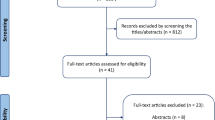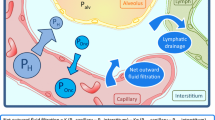Abstract
Accumulation of extravascular lung water (EVLW) is a hallmark of pulmonary edema and acute respiratory distress syndrome (ARDS) of various etiologies [1]. Increased EVLW is associated with a high mortality rate [1–3]. Thus, in critically ill patients, the balance and maintenance of cardiac preload and vital organ perfusion should be thoroughly weighed against the deleterious effects of worsening pulmonary edema, and quantification of EVLW may offer a valuable therapeutic guide to providers of intensive care.
Access this chapter
Tax calculation will be finalised at checkout
Purchases are for personal use only
Similar content being viewed by others

References
Sakka SG (2013) Extravascular lung water in ARDS patients. Minerva Anestesiol 79:274–284
Sakka SG, Klein M, Reinhart K, Meier-Hellmann A (2002) Prognostic value of extravascular lung water in critically ill patients. Chest 122:2080–2086
Jozwiak M, Silva S, Persichini R et al (2013) Extravascular lung water is an independent prognostic factor in patients with acute respiratory distress syndrome. Crit Care Med 41:472–480
Kirov MY, Kuzkov VV, Bjertnaes LJ (2005) Extravascular lung water in sepsis. In: Vincent JL (ed) Yearbook of Intensive Care and Emergency Medicine. Springer-Verlag, Berlin, Heidelberg, New York, pp 449–461
Kuzkov VV, Suborov EV, Kirov MY et al (2010) Radiographic lung density assessed by computed tomography is associated with extravascular lung water content. Acta Anaesthesiol Scand 54:1018–1026
Brown LM, Liu KD, Matthay MA (2009) Measurement of extravascular lung water using the single indicator method in patients: research and potential clinical value. Am J Physiol Lung Cell Mol Physiol 297:L547–L558
Tagami T, Kushimoto S, Yamamoto Y et al (2010) Validation of extravascular lung water measurement by single transpulmonary thermodilution: human autopsy study. Crit Care 14:R162
Boussat S, Jacques T, Levy B et al (2002) Intravascular volume monitoring and extravascular lung water in septic patients with pulmonary edema. Intensive Care Med 28:712–718
Mitchell JP, Schuller D, Calandrino FS, Schuster DP (1992) Improved outcome based on fluid management in critically ill patients requiring pulmonary artery catheterization. Am Rev Respir Dis 145:990–998
Sakka SG, Ruhl CC, Pfeiffer UJ et al (2000) Assessment of cardiac preload and extravascular lung water by single transpulmonary thermodilution. Intensive Care Med 26:180–187
Kirov MY, Kuzkov VV, Kuklin VN, Waerhaug K, Bjertnaes LJ (2004) Extravascular lung water assessed by transpulmonary single thermodilution and postmortem gravimetry in sheep. Crit Care 8:R451–R458
Kuzkov VV, Kirov MY, Sovershaev MA et al (2006) Extravascular lung water determined with single transpulmonary thermodilution correlates with the severity of sepsis-induced acute lung injury. Crit Care Med 34:1647–1653
Berkowitz DM, Danai PA, Eaton S, Moss M, Martin GS (2008) Accurate characterization of extravascular lung water in acute respiratory distress syndrome. Crit Care Med 36:1803–1809
Phillips CR, Chesnutt MS, Smith SM (2008) Extravascular lung water in sepsis-associated acute respiratory distress syndrome: indexing with predicted body weight improves correlation with severity of illness and survival. Crit Care Med 36:69–73
Tagami T, Sawabe M, Kushimoto S, et al (2013) Quantitative diagnosis of diffuse alveolar damage using extravascular lung water. Crit Care Med, Jun 11 [Epub ahead of print], PMID: 23760152
Martin GS, Eaton S, Mealer M, Moss M (2005) Extravascular lung water in patients with severe sepsis: a prospective cohort study. Crit Care 9:R74–R82
Dellinger RP, Levy MM, Rhodes A et al (2013) Surviving Sepsis Campaign: international guidelines for management of severe sepsis and septic shock: 2012. Crit Care Med 41:580–637
Le Tourneau JL, Pinney J, Phillips CR (2012) Extravascular lung water predicts progression to acute lung injury in patients with increased risk. Crit Care Med 40:847–854
Murphy CV, Schramm GE, Doherty JA et al (2009) The importance of fluid management in acute lung injury secondary to septic shock. Chest 136:102–109
Cordemans C, De Iaet I, Van Regenmortel N et al (2012) Fluid management in critically ill patients: the role of extravascular lung water, abdominal hypertension, capillary leak, and fluid balance. Ann Intensive Care 2(1):S1
Aman J, Groeneveld AB, van Nieuw Amerongen GP (2012) Predictors of pulmonary edema formation during fluid loading in the critically ill with presumed hypovolemia. Crit Care Med 40:793–799
Smetkin AA, Kuzkov VV, Suborov EV, Kulina IS, Kirov MY, Bjertnaes LJ (2009) The assessment of severity of pulmonary edema in patients with septic shock сombined with direct and indirect acute lung injury. Intensive Care Med 35(1):246 (abst)
Michard F, Fernandez Mondejar E, Kirov M, Malbrain ML, Tagami T (2012) A new and simple definition for acute lung injury. Crit Care Med 40:1004–1007
Kushimoto S, Endo T, Yamanouchi S et al (2013) Relationship between extravascular lung water and severity categories of acute respiratory distress syndrome by the Berlin definition. Crit Care 17:R132
Kushimoto S, Tairo Y, Kitazawa Y et al (2012) The clinical usefulness of extravascular lung water and pulmonary vascular permeability index to diagnose and characterize pulmonary edema: a prospective multicenter study on the quantitative differential diagnostic definition for acute lung injury/acute respiratory distress syndrome. Crit Care 16:R232
Eisenberg PR, Hansbrough JR, Anderson D, Schuster DP (1987) A prospective study of lung water measurements during patient management in an intensive care unit. Am Rev Respir Dis 136:662–668
Zeravik J, Borg U, Pfeiffer UJ (1990) Efficacy of pressure support ventilation dependent on extravascular lung water. Chest 97:1412–1419
Smetkin AA., Kuzkov VV, Suborov EV, Bjertnaes LB, Kirov MY (2012) Increased extravascular lung water reduces the efficacy of alveolar recruitment maneuver in acute respiratory distress syndrome. Crit Care Res Pract: Article ID 606528
Fernández Mondéjar E, Vazquez Mata G, Cárdenas A, Mansilla A, Cantalejo F, Rivera R (1996) Ventilation with positive end-expiratory pressure reduces extravascular lung water and increases lymphatic flow in hydrostatic pulmonary edema. Crit Care Med 24:1562–1567
Smetkin AA, Kirov MY, Kuzkov VV et al (2009) Single transpulmonary thermodilution and continuous monitoring of central venous oxygen saturation during off-pump coronary surgery. Acta Anaesth Scand 53:505–514
Goepfert MS, Reuter DA, Akyol D, Lamm P, Kilger E, Goetz AE (2007) Goal-directed fluid management reduces vasopressor and catecholamine use in cardiac surgery patients. Intensive Care Med 33:96–103
Goepfert MS, Richter HP, Eulenburg CZ, et al (2013) Individually optimized hemodynamic therapy reduces complications and length of stay in the intensive care unit. Anesthesiology (in press)
Lenkin AI, Kirov MY, Kuzkov VV, et al (2012) Comparison of goal-directed hemodynamic optimization using pulmonary artery catheter and transpulmonary thermodilution in combined valve repair: a randomized clinical trial. Crit Care Res Pract 2012: article ID 821218
Groeneveld AB, Verheij J, van den Berg FG, Wisselink W, Rauwerda JA (2006) Increased pulmonary capillary permeability and extravascular lung water after major vascular surgery: effect on radiography and ventilatory variables. Eur J Anaesthesiol 23:36–41
Kuzkov VV, Suborov EV, Kirov MY et al (2007) Extravascular lung water after pneumonectomy and one-lung ventilation in sheep. Crit Care Med 35:1550–1559
Naidu BV, Dronavalli VB, Rajesh PB (2009) Measuring lung water following major lung resection. Interact Cardiovasc Thorac Surg 8:503–506
Kuzkov V, Uvarov D, Kruchkov D, Kirov M, Nedashkovsky E, Bjertnaes L (2007) Determination of extravascular lung water after pneumonectomy and lung resection. Acta Anaesth Scand 51(118):10 (abst)
Sato Y, Motoyama S, Maruyama K et al (2007) Extravascular lung water measured using single transpulmonary thermodilution reflects perioperative pulmonary edema induced by esophagectomy. Eur Surg Res 39:7–13
Oshima K, Kunimoto F, Hinohara H et al (2008) Evaluation of respiratory status in patients after thoracic esophagectomy using PiCCO system. Ann Thorac Cardiovasc Surg 14:283–288
Pino-Sanchez F, Lara-Rosales R, Guerrero-Lopez F et al (2009) Influence of extravascular lung water determination in fluid and vasoactive therapy. Trauma 67:1220–1224
Holm C, Mayr M, Hörbrand F et al (2005) Reproducibility of transpulmonary thermodilution measurements in patients with burn shock and hypothermia. J Burn Care Rehabil 26:260–265
Kraft R, Herndon DN, Branski LK, Finnerty CC, Leonard KR, Jeschke MG (2013) Optimized fluid management improves outcomes of pediatric burn patients. J Surg Res 181:121–128
Aboelatta Y, Abdelsalam A (2013) Volume overload of fluid resuscitation in acutely burned patients using transpulmonary thermodilution technique. J Burn Care Res 34:349–354
Adler C, Reuter H, Seck C, Hellmich M, Zobel C (2013) Fluid therapy and acute kidney injury in cardiogenic shock after cardiac arrest. Resuscitation 84:194–199
Mutoh T, Kazumata K, Ajiki M, Ushikoshi S, Terasaka S (2007) Goal-directed fluid management by bedside transpulmonary hemodynamic monitoring after subarachnoid hemorrhage. Stroke 38:3218–3224
Sato Y, Isotani E, Kubota Y, Otomo Y, Ohno K (2012) Circulatory characteristics of normovolemia and normotension therapy after subarachnoid hemorrhage, focusing on pulmonary edema. Acta Neurochir (Wien) 154:2195–2202
Huber W, Umgelter A, Reindl W et al (2008) Volume assessment in patients with necrotizing pancreatitis: a comparison of intrathoracic blood volume index, central venous pressure, and hematocrit, and their correlation to cardiac index and extravascular lung water index. Crit Care Med 36:2348–2354
Venkateswaran RV, Dronavalli V, Patchell V et al (2013) Measurement of extravascular lung water following human brain death: implications for lung donor assessment and transplantation. Eur J Cardiothorac Surg 43:1227–1232
Compton F, Hoffmann C, Zidek W, Schmidt S, Schaefer JH (2007) Volumetric hemodynamic parameters to guide fluid removal on hemodialysis in the intensive care unit. Hemodialysis International 11:231–237
Trof RJ, Beishuizen A, Cornet AD et al (2012) Volume-limited versus pressure-limited hemodynamic management in septic and nonseptic shock. Crit Care Med 40:1177–1185
Author information
Authors and Affiliations
Corresponding author
Editor information
Editors and Affiliations
Rights and permissions
Copyright information
© 2014 Springer International Publishing Switzerland
About this chapter
Cite this chapter
Kirov, M.Y., Kuzkov, V.V., Bjertnaes, L.J. (2014). Extravascular Lung Water as a Target for Goal-directed Therapy. In: Vincent, JL. (eds) Annual Update in Intensive Care and Emergency Medicine 2014. Annual Update in Intensive Care and Emergency Medicine, vol 2014. Springer, Cham. https://doi.org/10.1007/978-3-319-03746-2_22
Download citation
DOI: https://doi.org/10.1007/978-3-319-03746-2_22
Publisher Name: Springer, Cham
Print ISBN: 978-3-319-03745-5
Online ISBN: 978-3-319-03746-2
eBook Packages: MedicineMedicine (R0)



